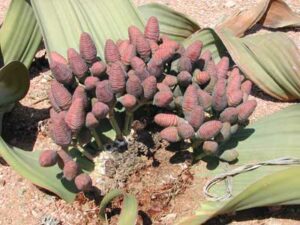Non flowering plants generally referred as cryptogams.
Non flowering plants are commonly known as cryptogams and some other are known as gymnosperms.
Cycads:
Cycads are the gymnosperms as they produce seeds. They contain a thick and woody trunk. They also contain a large, strong, evergreen, featherlike leaves.
Cycads produce unfertilised seeds and they are free in air and fertile through pollination process.
They can fix nitrogen with the help of nitrogen fixing bacteria like cyanobacteria at their roots. In this process neurotoxin is produced and if it consumed by humans may result in neurological disorders.

Ginkgo:
This is a native plant of china and oldest plant living on earth for about, more than 200 million years.
It has a large fan shaped leaves. These are consumed by humans in the curing of memory problems.
Gnetophytes:
Gnetophytes is a vascular, gymnosperm plant. There three types in gnetophyte trees.
Ephedra:
In ephedra species there are nearly 65 different species. Generally ephedra species have branches and form shrubs. These are distributed in cool and dry regions.
Gnetum:
There are nearly 30 species in this category. Gnetum species climb high or may be 9 meters tall.
The seeds can be cooked or roasted and young leaves can be eaten.
Welwitschia:
This is a gymnosperm species. This has unbranched stem and two persistent leaves that grow lifelong. These leaves are eaten by animals and survive in drought conditions.

Ferns:
It is a vascular plant, contains complex leaves called megaphylls. They reproduce via spores but not by seeds and flowers.

Mosses:
Mosses are tiny, non-flowering plans. These are non-vascular plants, come under bryophyte family. They generally form thick green clumps in shady places. They contain small leaves attached to a stem, they may be branched or unbranched. They generally reproduce through spores.
liver-worts:
These are non-vascular plants, they reproduce through two different cycles. Haploids and diploids.
The sporophyte forms haploid spores and these combine together and form gametophyte. This gametophyte may develop into a new cell or gametes combine together and form zygote. This zygote is diploid cell. Zygote can undergo cell division process even meiosis.
The liver worts leaves were used for curing liver disorders in olden days.
Psilotales:
These are the vascular plants. They come under ferns family. They reproduce through spores.
Club mosses:
Club mosses are the perpetual, ever green plants with a great many small leaves.
Horn worts:
These are the group of bryophyte family. They contain elongated horn like structure called sporophyte.
In haploid gametophyte stage the plant body develops. In this stage it develops like a thread like thallus or rosette. Only one chloroplast present in each cell of thallus. They reproduce through spores.
Horse tails:
They come under the family of Equisetaceae, they are usually gro like herbs. Another name for this is bottle brush or horse herbs.
This plant has been used from greek period as a curative for curing of tuberculosis, osteoporesis( bone loss), and kidney related problems, wound healing, controlling bleeding etc.
Sensational snake plant:
There are nearly 25 types of sensational snake plants. The scientific name is sansevieria. It contains large and lean leaves because of this feature this is also known as mother- in- laws tongue plant.
Glorious golden pothos:
These are commonly known as money plant. They have thick, heart shaped leaves.
These plants are generally grown in houses. This has nick name devil’s ivy plant.
Cool coleus:
It usually grown in houses in plant pots, it is available in different colors like light green, maroon green, and deep marron.
Earnest entharium:
This has a beautiful red color leaves, and can be grown out door or in door.
Junipers:
Junipes come under family of cupressaceae. There are nearly 50-60 species are present in northern hemisphere.
These are evergreen shurbs or tiny trees with berry like cones. Some speceis may have aromatic cones.
Cedars:
Cedar comes under family of pinaceae with the genus coniferous. They are found vastly in western himalayan regions as well as mediterranean regions.
Cypresses:
It comes under family of cupraceae family with the genus cupressus. There many species in cypress because of their extensive cultivation. The species may differ in size, colour, and a variety of forms.
These are commonly used as ornamental plants in parks , temples, gardens and can be used in furniture because of their extensive durability of timber.
Firs:
These are the ever green species, come under the family of pinaceae.
There are nearly 48-56 species and found in north and central America, Asia, Europe and north Africa mostly in mountain regions.
They are closely related to the genus of cedrus. Some species are used as timber and some other as ornamental plants in parks, gardens etc.
Pines:
It grows like shrub or coniferous plant. It come under the family of pinaceae having a genus pinus.
The family of pine is the largest family among coniferous plants.
There are nearly 126 species among them most of the species are used as wood, and as a lumer.
Red woods:
Red wood plant is one of the tallest plants, may grow around 300 feet and can live for about 100 years.
Red woods belong to california and oregon. These are also known as sequonia becuase they look like sequoiadendron giganteum.
They require some special climatic conditions like sufficient rain fall, cool air in winter, and summer Fogg for thriving.
Yews:
They are the long living coniferous shurbs. They are slow growers. They come under family of taxaceae. These are commonly found in temperate and tropical mountanious forests of the northern hemisphere.
They grow under moist conditions, sunlight. It is generally grown as ornamental plant.
Larches:
These plants come under pinaceae family having the genus larix.
They grow well in cool temperate northern hemi sphere.
Larches turn yellow and lose needles in autumn season.
Kauris:
These are the coniferous, ever green plants. These plants come under the family of Araucariaceae family. They can grow under low light conditions.
Also Read:
- What is the chemical structure of carbohydrates
- Do mitochondria have ribosomes
- Molecules active transport examples
- Are bacteria autotrophs or heterotrophs
- Chemoautotrophs examples
- Saprophytic bacteria examples
- Water movement through cell membrane
- Genetic diversity examples
- Fungi parasites examples
- Do eukaryotic cells have cytoplasm

Hi…I am Nagasrilakshmi Narne, a postgraduate in Biotechnology and English. also completed my B.Ed. I worked in Vimtalabs as a project trainee and I have work experience as a faculty of English. So I can explain topics in simple language.
Let’s connect through LinkedIn